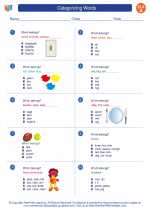Categorizing Words: Explanation and Study Guide
What are Categorizing Words?
Categorizing words are words that are used to classify or group items, people, or ideas based on their similarities or differences. These words help us organize and understand the world around us by placing things into different categories.
Types of Categorizing Words
There are several types of categorizing words, including:
- Nouns: These are words that represent people, places, things, or ideas. They can be categorized into common nouns (e.g., cat, city) and proper nouns (e.g., Mary, Paris).
- Adjectives: These words are used to describe or modify nouns. They can be categorized into descriptive adjectives (e.g., beautiful, tall) and demonstrative adjectives (e.g., this, that).
- Verbs: Verbs are action words or states of being. They can be categorized into action verbs (e.g., run, jump) and linking verbs (e.g., is, feel).
- Adverbs: Adverbs modify verbs, adjectives, or other adverbs. They can be categorized into adverbs of manner (e.g., quickly, carefully) and adverbs of frequency (e.g., often, rarely).
- Conjunctions: These are words used to connect words, phrases, or clauses. They can be categorized into coordinating conjunctions (e.g., and, but) and subordinating conjunctions (e.g., because, although).
How to Identify Categorizing Words
To identify categorizing words in a sentence, look for words that help classify, describe, or connect other words. Nouns identify people, places, things, or ideas. Adjectives describe or modify nouns. Verbs express actions or states of being. Adverbs modify verbs, adjectives, or other adverbs. Conjunctions connect words, phrases, or clauses.
Study Guide
Here are a few tips to help you master categorizing words:
- Practice identifying nouns, adjectives, verbs, adverbs, and conjunctions in sentences.
- Create flashcards with different categorizing words and their definitions to study and memorize.
- Use categorizing words in your own writing to reinforce your understanding of their roles in sentences.
- Play word games or quizzes that involve categorizing words to make learning fun and interactive.
Understanding categorizing words is essential for building strong language skills and effective communication. With practice and patience, you can become proficient in identifying and using categorizing words in your writing and speech.
[Categorizing Words] Related Worksheets and Study Guides:
.◂English Language Arts Worksheets and Study Guides First Grade. Categorizing Words

 Worksheet/Answer key
Worksheet/Answer key
 Worksheet/Answer key
Worksheet/Answer key
 Worksheet/Answer key
Worksheet/Answer key
